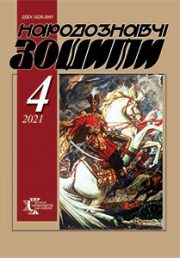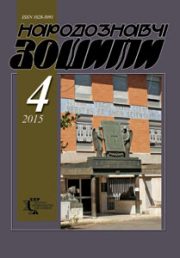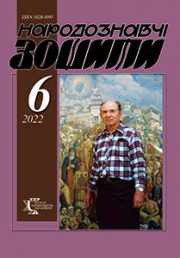The Ethnology Notebooks. 2024. № 3 (177), 501—509
UDK 572(477)”195/197″(091)
DOI https://doi.org/10.15407/nz2024.03.501
DEVELOPMENT OF UKRAINIAN ANTHROPOLOGY DURING 1950s — FIRST HALF of 1970s. RISES AND FALLS
SEGEDA Sergij
- ORCID ID htpp://orcid.org/0000-0001-6772-8387
- Doctor of Sciences in History. Chief Researcher
- at the Institute of Ethnology of the National Academy
- of Scienses of Ukraine,
- Department of Historical Ethnology,
- 15, Svobody Avenue, 79000, Lviv, Ukraine,
- Contacts: e-mail: sergij_segeda@ukr.net
Abstract. The article examines the main directions of scientific research and achievements of Physical Anthropology at the third stage of its development as a scientific discipline in Ukraine. This period covers the mid 1950s and mid 1970s.
The relevance of the research is determined by the lack of general studies on this issue. The purpose of the work is a general assessment of the activities of domestic anthropologists in this period, based on the complex application of historical-cultural and comparative-typological methods.
It was found that from the mid 1950s up to the mid 1970s, the only scientific anthropological center in Ukraine was the Anthropology group of the Department of Ethnography, IMFE Academy of Sciences of Ukrainian SSR. The researchers conducted large-scale surveys of the ancient and modern populations of Ukrainian territories. In order to highlight anthropological problems, a wide range of modern systems of signs and methods of their processing were involved, some of them were included into a program and practice of Physical Anthropology much later in the second half of XX century.
During this period, a number of monographs of the Ukrainian scientists were published, which have retained their scientific significance to these days. It was noted that the termination of the activities of the Anthropology group of the Ethnography Department, IMFE Academy of Sciences of Ukrainian SSR caused irreparable damage to the development of an important branch of ethnographic studies in Ukraine.
Keywords: paleanthropology, applied anthropology, craniology, anthropological composition of the Ukrainian people, hematology, odontology, dermatoglyphics.
Received 3.06.2024
REFERENCES
- Segeda, S. (2023). Development of Ukrainian anthropology in the 20—30 years of the 20th century. Gains and losses. The Ethnology notebooks, 1, 31—43. DOI https://doi.org/10.15407/nz2023.01.031 [in Ukrainian].
- (1960). Preface. Materials of anthropology of Ukraine (Issue 1, pp. 3—5). Kyiv: Vydavnyctvo AN URSR [in Ukrainian].
- Segeda, S. (2001). Anthropological composition of the Ukrainian people: ethnogenetic aspect. Kyiv: Vydavnyctvo im. O. Teligy [in Ukrainian].
- Segeda, S. (2021). Historical anthropology of Ukraine. Lviv: Institute of Ethnology of NAN of Ukraine [in Ukrainian].
- Segeda, S. (2010). Vasyl Dyachenko in the history of Ukrainian anthropology. University, 1, 79—85 [in Ukrainian].
- Segeda, S.P. (1997). Craniological and osteological collections. Ukrainian cultural values in Russia. Archaeological collections of Ukraine. Kyiv [in Ukrainian].
- Kuchtenko, І.M. (1972). To the history of the study of the physical development of children of Ukraine. Materials of anthropology of Ukraine (Issue 6, pp. 48—52). Kyiv: Naukova dumka (Issue 6, pp. 48—52) [in Ukrainian].
- Danilova, Je.I. (1965). Evolution of the hand in connection with issues of anthropogenesis. Kyiv: Naukova dumka [in Russian].
- Diachenko, V.D. (1961). Anthropological composition of the Ukrainian people in connection with some issues of its ethnogenesis. Abstr. diss… cand. biol. sciences. Moscow [in Russian].
- Diachenko, V.D. (1965). Anthropological composition of the Ukrainian people. Comparative study of the peoples of the Ukrainian SSR and adjacent territories. Kyiv: Naukova dumka [in Ukrainian].
- Alieksiejeva, T.I. (1966). Book review: Diachenko V.D. Anthropological composition of the Ukrainian people. Questions of anthropology (Issue 23, pp. 182—183). Кyiv [in Russian].
- Alieksiejeva, T.I. (1973). Ethnogenesis of the Eastern Slavs according to anthropological data. Moscow: Nauka [in Russian].
- Diachenko, V. (1992). Not just black eyebrows, brown eyes (anthropological types on the ethnic territory of the Ukrainian people). Viche, 4, 114—122 [in Ukrainian].
- Diachenko, V. (1972). New materials from the anthropology of Serbs, Croats, Slovenes, Montenegrins of Yugoslavia. Materials on anthropology of Ukraine (Issue 6, pp. 42—47). Kyiv: Naukova dumka [in Ukrainian].
- Zinievich, G.P. (1967). Drawings from paleoanthropology of Ukraine. Kyiv: Naukova dumka [in Russian].
- Zinievich, G.P., & Kruts, S.I. (1968). Anthropological characteristics of the ancient population of the territory of Ukraine (based on the materials of the expeditions of 1961—1963 years). Kyiv: Naukova dumka [in Ukrainian].
- Kruts, S.I. (1972). Population of the territory of Ukraine during the Copper-Bronze Age (according to anthropological data). Kyiv: Naukova dumka [in Russian].
- Zinievich, G.P. (1973). Anthropological materials from medieval burial grounds in Southwestern Crimea. Kyiv: Naukova dumka [in Russian].
- Lavrik, S.S., Karavanov, A.G., Danilova E.I., & etc. (1968). The distribution of blood antigens of the system ABO, MN, Rh among the population of the Ukraine in connection with some problems of etnic history. Moskow.
- Danilova, Je.I. (1971). Hematological typology and issues of ethnogenesis of the Ukrainian people. Kyiv: Naukova dumka [in Russian].
- Starovojtowa, R.А. (1979). Ethnic genogeography of the Ukrainian SSR. Kyiv: Naukova dumka [in Russian].
- Segeda, S.P. (1980). Odontological and dermatoglyphic characteristics of Ukrainians of the Middle Dnieper region in connection with issues of ethnogenesis. Abstr. diss. … cand. hist. sciences [in Russian].






